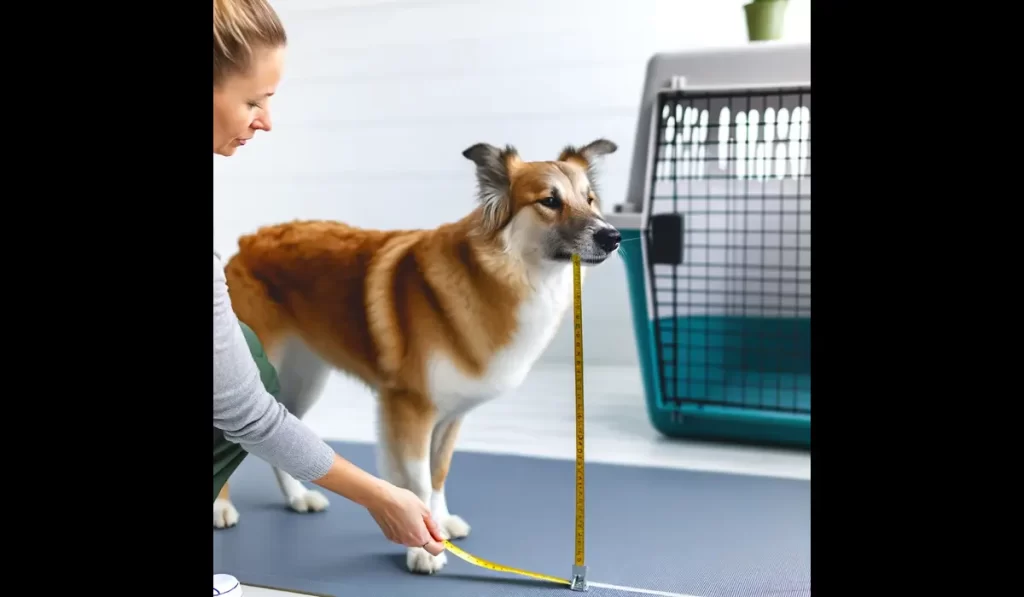Summary
To measure your dog for the perfect crate, have them stand straight. Measure their length from the tip of their nose to the base of their tail. Then, have them sit and measure their height from the floor to the top of their head or ears. Add 2-4 inches to both measurements for comfortable movement. While width isn’t directly measured, ensure the crate’s dimensions accommodate your dog’s length and height, allowing them to turn around. For puppies, estimate adult size. Check the crate’s weight limit. Travel crates should be snugger than home crates. Refer to size charts as a general guide, but always check specific crate dimensions.
Why is it Necessary to Choose a Perfect-Sized Crate?
Dogs are nest creatures, and owning a crate in your house provides them a comfortable place to retreat when they have to get off from everything. Crates are also useful for potty training your pet, keeping him secure. At the same time, you cannot oversee him, sleeping in at night and retreating to when the outside becomes noisy or frightening.
Crates have proven very useful to dog owners who keep on traveling frequently, not only to frequent travelers, and crates have proven beneficial even for house trainers. Using a crate while training the dog for the disciplines he has to maintain in the house has worked very well.
For example, when you notice that your dog has been over-excited and is moving here and there in the house, you want to control his movement. You can get him to the crate to control his excessive movements, which can also benefit canine potty training.
As you will use the crate regularly to train your dog properly, it becomes necessary to use a properly sized crate. Going for a crate smaller than your dog’s size can cause severe scratches to your pet’s skin.
Suppose you use a crate of a larger size. In that case, your intention of restricting the canine’s movements while it becomes anxious will not be fulfilled. Hence, it is important to choose a perfect-sized crate for the dog.
Why do dog owners face Difficulties in Choosing a Crate for their Canine?
Just like human beings, dogs also keep on growing over time. The canine might also get healthy as time passes, and depending upon your dog’s breed, it can also get huge.
These factors always need clarification for dog owners when buying a crate for their dog. Also, the dogs are sometimes not used to a very small crate. They often want a little more space for their free movements.
But when you take the pet on a journey, the size should be confined to restrict the dog’s movement in the journey to avoid the pet from getting hurt. This must be clarified for the dog owner while buying a crate.
How to Measure a Dog for a Crate?
Now, we have discussed the difficulties dog owners face while choosing a crate for their dog and why it is necessary to choose a perfect-sized crate. It’s time to discuss how you can properly measure the dog for buying a perfect size crate.
The dog owner’s steps to measure the dog are discussed below.
Measure the Length of the Dog
Measuring the dog’s length will help you get the proper size of the crate. Make sure you buy a crate a few inches more than the actual length of your dog so that your dog can fit perfectly in it. The steps to follow for measuring the dog’s length are discussed below.
Make Them Stand on the Floor
The first step is to measure the length of the canine standing straight on the ground. This is necessary because when the canine stands straight, you can only get a perfect measurement of its size.
Measure from the Tip of the Nose to the Tail
The next step you have to follow is to place one end of the measuring tape on the tip of the nose and stretch it to the canine’s tail. Make sure you are holding the pet straight with one of your hands, and you can also get help from anyone in the shop to have your dog straight.
After stretching the measuring tape from the nose to the canine’s tail, mark the inches on a note.
Measure with a Curved Tail
It is important to remember that whenever you measure the dog’s length, you should measure it with a curved tail.
This is because if you measure by stretching the dog’s tail, it will get you an extremely larger crate than your dog’s size, as most of the time, the dog keeps its tail curved. So, measuring the pet with a curved tail is important.
Add Two to Four Inches of Extra
Now, if you go for the exact measurement of length you have taken of the dog, then the movement of the dog will get more confined, and the dog will also have difficulties in sitting in the crate due to a narrow space.
Therefore, you always go for a few inches larger than the actual measurement.
Measure the Height of the Dog
Now, after measuring the length of the canine, you also have to measure the dog’s height to get a perfect-sized crate. The steps to measure the crate’s height are discussed below.
Make the Dog Sit Straight
To measure the dog’s height, the first step you have to follow is to make the dog sit straight on the ground. The dog might not sit rapidly after hearing your command. If you face difficulties making the canine sit, you can also use some treats.
It is also necessary that the dog keep its head straight during the measurement, so you can also get the help of anyone in the crate shop to hold the head of the dog straight.
Measure from the Paws to the Ears of the Canine
Now, after making the dog sit straight, all you can do is just put one end of the measuring tape on your dog’s paws, then extend it up to the ears of the canine. Remember to note the inches on the measuring tape while measuring the canine’s height.
Add Two to Four Inches of Extra
It doesn’t matter if you are measuring the height or length. You should always go for two to four inches extra while buying the crate to get the best fit.
Measure the Width of the Crate
It is one of the easiest steps to follow while measuring a dog for a crate. This is because you don’t need to measure the width of a dog, which can be determined simply by the height and length of the dog you have measured.
Weight Limit of the Crate
This is the most important step in the entire process. If you do not compare your dog’s weight with the weight that the crate you have chosen can carry, then the crate might break within a few days of usage.
That’s why it is very important to measure the canine’s weight first and then compare it with the weight limit of the crate to go with the crate you have chosen.
All the above-discussed steps are experimentally proven to work best for dog owners while measuring a dog for a crate. So dog owners can follow these steps without hesitation and choose the best.
Table to Help You in Choosing a Crate for Your Dog
We have come up with a table you prefer when buying a dog crate. The information in the table includes the most found sizes of dogs, crate dimensions, and height. So you can refer to this table if your dog is of the size mentioned.
Certainly! Here’s the information presented in a more structured format:
Certainly! Here’s the information presented in a properly formatted table:
“`
| Size of Dogs | Dimensions of Crate (Length x Width x Height) | Max Height | Max Length | Recommended Breeds |
|————–|———————————————-|————|————|—————————|
| 18 | 18L x 12W x 14H inches | 10 | 14 | Chihuahua, Pomeranian |
| 22 | 22L x 13W x 15.5H inches | 11.5 | 18 | Yorkshire Terrier, Poodle |
| 24 | 24L x 18W x 19.5H inches | 15.25 | 20 | Havanese, Pug |
| 30 | 30L x 19W x 21H inches | 17 | 26 | French Bulldog, Pinscher |
| 36 | 36L x 23W x 25H inches | 21 | 32 | Beagle, Bulldog |
| 42 | 42L x 28W x 30H inches | 26 | 38 | Golden Retriever, Pitbull |
| 48 | 48L x 30W x 32.5H inches | 28.5 | 46 | German Shepherd, Doberman |
“`
Feel free to copy and paste this table directly into your article. Let me know if you need any further assistance!
This table presents the size of dogs, the corresponding crate dimensions, the maximum height and length allowed, and recommended breeds for each crate size.
A dog owner can go through the table and the abovementioned steps while learning how to measure a dog for a crate.
Dog owners who have not used a crate will only be able to properly measure the canine for the crate if they follow a proper guide.
These measurements will surely yield the best results. You’re doing it right. If addressing is crucial, indicate


